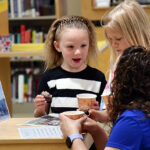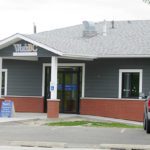Home »

Columbia House Healing Garden hosts third seminar
By Anne Jardine
To celebrate the arrival of spring, Columbia House Healing Garden Society presented its third in a series of seminars at Invermere Christ Church Trinity on Thursday, March 21.
Society director and host Betty Newton introduced five speakers who covered a variety of topics related to health and gardens.
Lyn Steedman of Winderberry Nursery & Edible Acres titled her talk Vim & Vigour Veggies. “It is important to know where your food comes from, who grows it, and how it is grown,” she said. “If you can’t grow it yourself, you can at least enjoy the benefits of buying it from trusted organic growers as close to home as possible. Organic agriculture is preferred because it is socially, and ecologically sustainable, and good for the local economy. It builds rather than depletes the soil by using green manure and organic compost. It is a holistic alternative to chemically driven industrial agriculture.”
One example of health benefits from fresh veggies is Lin Steedman’s favourite garden delight, Greek salad. Each ingredient brings its particular nutrients: red onions help detoxify the blood, cucumbers promote digestion, tomatoes are a source of vitamin C and reduce risk of cancer and heart disease, sweet peppers help promote healthy teeth and bones, garlic boosts the immune system, basil lowers blood sugars. Add flavourful olives, olive oil, wine or balsamic vinegar, and feta cheese, and you have a complete spectrum of nutrition.
Anna Steedman, also of Winderberry Nursery & Edible Acres, presented information on herb gardening. “Herbs are abundant and easy to grow,” she said. “We use them fresh and dried in our café, and we love experimenting with different combinations of herbs. They offer us many health benefits, they add flavor and aroma to our food. Some herbs that grow well in this valley are: sage, which improves brain function and eyesight; peppermint, which is rich in iron and has been used in pain management; rosemary, which aids in memory and helps regulate heart function; thyme, which lowers blood pressure; and parsley, which aids digestion, sweetens breath, and is good for the teeth and gums.”
Aroma therapist Heather Fischbuch introduced samples of a number of essential oils including cinnamon, fir, hissop, clove, apple, cedar, chamomile, coriander, and rose. Essential oils are distilled essences of concentrated plant material. She explained that the science behind Aroma Therapy is that the essential oils stimulate the brain, and this can be particularly helpful in controlling pain, regulating respiration, anxiety, and treating dementia. “We know that much of the frustration of dementia is caused by the loss of memory. We also know that the sense of smell is directly linked to memory function – smell triggers memory. It begins with the part of the brain called the amygdala. The amygdala is located just behind the nose, and it is where the smell receptor is located. The amygdala also triggers the release of hormones that regulate mood. It’s an example of chemistry in action. We have found that he right combination of essential oils can significantly improve many health outcomes.”
Kallista Pruden of Avalily Permaculture and Earthskills Institute gave an overview of her work in the field of biophilic design. She first defined what she termed the biophilic hypothesis, which states that humans possess an innate tendency to connect with nature. “Such connection has been shown to improve cognitive health, elevate mood by way of antidepressant microbes in the soil, reduce the development of myopia, and enhance spiritual health. Biophilic design brings elements of nature inside our homes and other built spaces. Design elements can include natural materials such as wood and stone, light, operable windows for air flow, perspective and view-scapes, plants, animals, refuge, privacy, safety, fountains or water features, opportunities for risk, heights and levels, and hidden or mysterious features. These elements are especially good for stimulating children and the elderly, and if the space is healthy for children and the elderly, it’s good for everyone,” she said.
The final presentation was a Healing Garden progress report given by Society chair John Newton.
He showed slides of the plans and the work so far, and announced, “Phase One of the garden construction is complete. The retaining walls have been set in place, the spaces have been defined, ramps and paths have been completed. The structure is pretty well laid in.
“The garden area connects Columbia House, the hospice rooms, the Hospital and community health unit, and it is easily accessible from Columbia Garden Village and Ivy House. We are now moving into phase two in time for spring plantings. We can get started as soon as the frost is out of the ground, but we are going to need about $150,000 beyond what we already have. Hence, this fundraiser.
“Maintenance agreements are in place with District of Invermere, so that’s a plus. Several local businesses have donated in-kind goods and services and we appreciate all those sponsorships. If you know anyone who wants to leave a legacy and make a real meaningful investment in the health of our region, have them contact us in person of through the website so they can help our garden grow.”
Lead image: John Newman, Kalista Pruden, Lyn Steedman, Anna Steedman, Betty Newman society director, Johanna Roggeman, Nora Croft and (front) Heather Fischbuch take a moment before they go off to mingle and answer follow-up questions from the audience. Anne Jardine photo
e-KNOW







